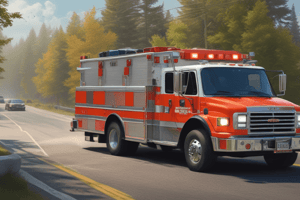Podcast
Questions and Answers
What is the primary responsibility of each employee regarding TFD vehicles?
What is the primary responsibility of each employee regarding TFD vehicles?
- Ensure to follow safety protocols only during emergencies.
- Assist in reporting incidents after they occur.
- Make every effort to prevent accidental injury, property damage, or death. (correct)
- Maintain the vehicles to avoid breakdowns.
Which of the following outcomes are employees expected to prevent while operating TFD vehicles?
Which of the following outcomes are employees expected to prevent while operating TFD vehicles?
- Increased vehicle efficiency and performance.
- Improper use of vehicle equipment.
- Accidental injury, property damage, and death. (correct)
- Routine vehicle maintenance issues.
In what kind of operation must employees assist to prevent adverse outcomes?
In what kind of operation must employees assist to prevent adverse outcomes?
- Operations involving non-emergency vehicles.
- Only during emergency operations.
- Routine and emergency operations. (correct)
- Routine operations only.
The person assigned to spotter will follow what EOG standards?
The person assigned to spotter will follow what EOG standards?
What does proper securing of a apparatus include?
What does proper securing of a apparatus include?
What is required for air and light units to respond with emergency lights and sirens?
What is required for air and light units to respond with emergency lights and sirens?
When can non-emergency vehicles use four-way flashers and other warning lights?
When can non-emergency vehicles use four-way flashers and other warning lights?
Which of the following actions is prohibited for personnel while driving?
Which of the following actions is prohibited for personnel while driving?
What is the main focus when non-emergency vehicles park at an emergency scene?
What is the main focus when non-emergency vehicles park at an emergency scene?
Which device must not be used simultaneously while driving?
Which device must not be used simultaneously while driving?
What is the maximum duration that vehicles can remain inside the apparatus room with the exhaust system connected?
What is the maximum duration that vehicles can remain inside the apparatus room with the exhaust system connected?
Which systems are used to manage exhaust in the apparatus room?
Which systems are used to manage exhaust in the apparatus room?
Under which condition can internal combustion engines operate inside the fire station?
Under which condition can internal combustion engines operate inside the fire station?
What must emergency vehicles do at negative rights-of-way?
What must emergency vehicles do at negative rights-of-way?
How should vehicles be driven when entering or leaving the apparatus room?
How should vehicles be driven when entering or leaving the apparatus room?
What happens if the exhaust hose is exposed to elevated engine speeds?
What happens if the exhaust hose is exposed to elevated engine speeds?
What is required for a vehicle to be classified as an emergency vehicle?
What is required for a vehicle to be classified as an emergency vehicle?
What must not be altered or disabled in relation to the exhaust and ventilation systems?
What must not be altered or disabled in relation to the exhaust and ventilation systems?
What is the recommended number of spotters for backing fire apparatus with an obstructed view?
What is the recommended number of spotters for backing fire apparatus with an obstructed view?
What should be done before backing if a backer is unavailable?
What should be done before backing if a backer is unavailable?
Which of the following is NOT part of properly securing unattended apparatus/vehicles?
Which of the following is NOT part of properly securing unattended apparatus/vehicles?
What action is prohibited within the apparatus bay?
What action is prohibited within the apparatus bay?
What is the appropriate safety for all employees while a vehicle is in motion?
What is the appropriate safety for all employees while a vehicle is in motion?
When parking light vehicles, how should the wheels be positioned?
When parking light vehicles, how should the wheels be positioned?
What should be used on heavy-duty apparatus with a GVWR of 15,000 pounds or more to prevent rolling?
What should be used on heavy-duty apparatus with a GVWR of 15,000 pounds or more to prevent rolling?
What is the proper transmission setting for most light vehicles when parked?
What is the proper transmission setting for most light vehicles when parked?
The person assigned as a spotter will follow standard hand signals described in EOG 200 ._2.1.
The person assigned as a spotter will follow standard hand signals described in EOG 200 ._2.1.
All employees will wear a seatbelt or safety harness while an apparatus is in motion. Discipline will be administered based on article __ of the CBA
All employees will wear a seatbelt or safety harness while an apparatus is in motion. Discipline will be administered based on article __ of the CBA
Flashcards
Vehicle Operations Safety Goal
Vehicle Operations Safety Goal
To prevent accidents, injuries, property damage, and fatalities during vehicle operations.
Vehicle Compliance
Vehicle Compliance
All vehicles must adhere to all laws, regulations, and rules set by departments, municipalities, states, and the federal government.
Backing Apparatus
Backing Apparatus
Avoid backing whenever possible; if necessary, use spotters for guidance and standard hand signals.
Drive-Through Stations
Drive-Through Stations
Signup and view all the flashcards
360° Walk-Around
360° Walk-Around
Signup and view all the flashcards
Securing Unattended Vehicles
Securing Unattended Vehicles
Signup and view all the flashcards
Seat Belt Requirement
Seat Belt Requirement
Signup and view all the flashcards
Seat Belt Policy Enforcement
Seat Belt Policy Enforcement
Signup and view all the flashcards
Siren and Air Horn Use
Siren and Air Horn Use
Signup and view all the flashcards
Exiting Vehicles
Exiting Vehicles
Signup and view all the flashcards
Equipment and Compartment Security
Equipment and Compartment Security
Signup and view all the flashcards
Engine Operation Guidelines
Engine Operation Guidelines
Signup and view all the flashcards
Ventilation System Role
Ventilation System Role
Signup and view all the flashcards
Exhaust System Duration
Exhaust System Duration
Signup and view all the flashcards
Appliance Room Entry/Exit
Appliance Room Entry/Exit
Signup and view all the flashcards
Emergency Vehicle Classification
Emergency Vehicle Classification
Signup and view all the flashcards
Emergency Vehicle Traffic Laws
Emergency Vehicle Traffic Laws
Signup and view all the flashcards
Non-Emergency Vehicle Signal Use
Non-Emergency Vehicle Signal Use
Signup and view all the flashcards
Non-Emergency Vehicle Traffic Compliance
Non-Emergency Vehicle Traffic Compliance
Signup and view all the flashcards
Mobile Phone Use
Mobile Phone Use
Signup and view all the flashcards
Driving Focus
Driving Focus
Signup and view all the flashcards
Safe Driving Practices
Safe Driving Practices
Signup and view all the flashcards
Defensive Driving
Defensive Driving
Signup and view all the flashcards
Road Awareness
Road Awareness
Signup and view all the flashcards
Vehicle Maintenance
Vehicle Maintenance
Signup and view all the flashcards
Study Notes
Vehicle Operations Safety
- Employees must actively prevent accidents, injuries, property damage, or fatalities during vehicle operations.
- All vehicles must comply with Departmental, Municipal, State, and Federal laws, rules, and regulations.
Apparatus/Vehicle Safety
- Avoid backing apparatus whenever possible; if necessary, assign one or two spotters for guidance.
- Use standard hand signals for communication during backing.
- Discourage backing apparatus into drive-through stations and utilize rear-facing cameras when available.
- Perform a 360° walk-around to identify hazards before reversing if no spotter is present.
- Secure unattended vehicles by removing keys, locking doors, setting parking brakes, properly shifting transmissions, turning wheels into curbs, and using wheel chocks on heavy-duty vehicles.
Seat Belt and Safety Regulations
- All personnel must wear seat belts or safety harnesses while vehicles are in motion.
- Seat belt policies are enforced under Article 28 of the Collective Bargaining Agreement.
Emergency Response Procedures
- Activation of sirens and air horns is prohibited inside the apparatus bay.
- Personnel must exit vehicles only after coming to a complete stop.
Equipment and Engine Operation Guidelines
- Secure all equipment and close compartment doors before moving vehicles.
- Internal combustion engines may only operate inside fire stations for vehicle movement; exhaust systems must be used during operation indoors.
- Ventilation systems automatically manage exhaust during vehicle movement; vehicles should not remain connected to the exhaust system for over five minutes.
- Vehicles must enter and leave the apparatus room at idle speed to prevent damage to exhaust hoses.
Emergency Vehicles Regulations
- Only vehicles equipped with emergency lights and sirens are classified as emergency vehicles.
- Emergency vehicles must stop at red lights, stop signs, and other specified traffic controls, and comply with traffic laws while responding.
Non-Emergency Vehicle Guidelines
- Non-emergency vehicles should not use emergency signals while driving; these signals can be used only when parked to warn oncoming traffic.
- Non-emergency vehicles must obey all traffic laws and park in a manner that does not obstruct emergency response.
Mobile Telephone Policy
- Personnel are prohibited from using hand-held mobile phones while driving; hands-free devices must be used or one must pull over safely to make calls.
Studying That Suits You
Use AI to generate personalized quizzes and flashcards to suit your learning preferences.




